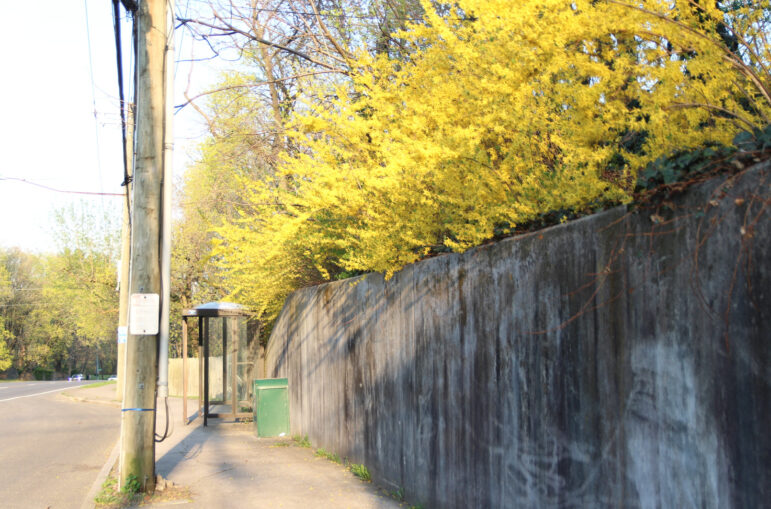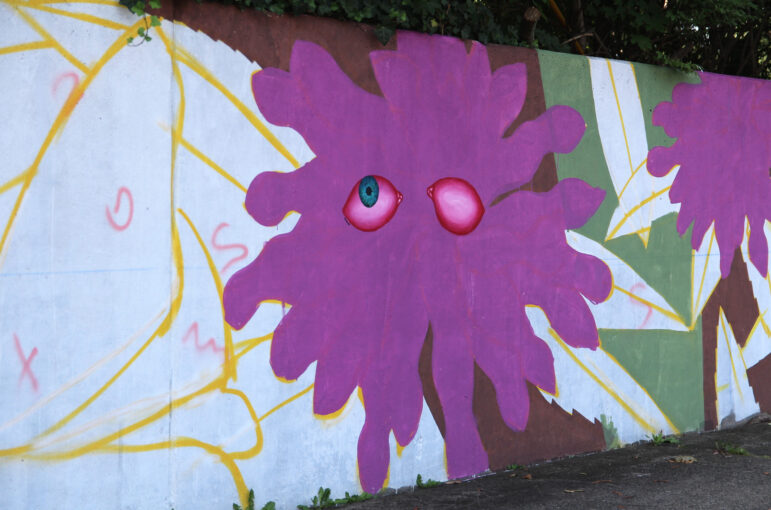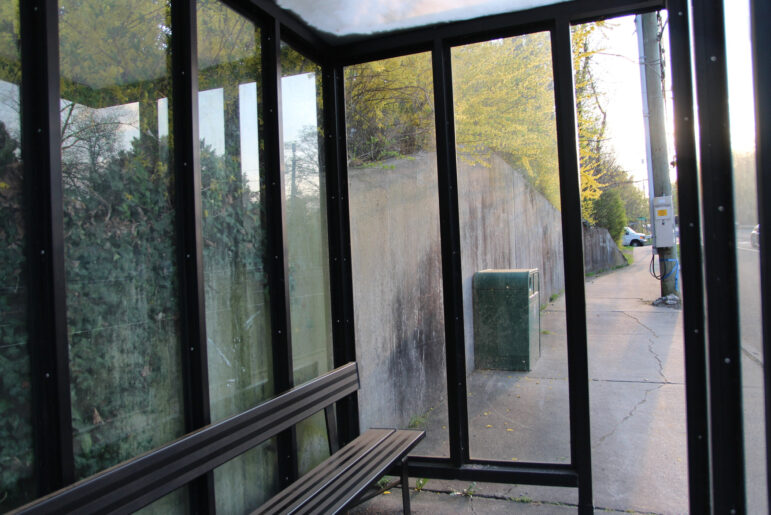On Monday night the RTM voted by a significant margin to approve completion of a partially painted mural on East Putnam Ave.
The vote was 121 in favor, 68 opposed and 5 abstentions.
People were passionate on both sides of the controversy, with some proponents characterizing objections to the mural as racist.
Last May a stop work order forced professional muralist Nelson Rivas of Newburgh, NY to put down his brushes after partially painting a “pollinator” themed, brightly colored mural on a 100 ft long grim expanse of concrete on East Putnam Ave.

The Conservation Commission and its ad hoc pollinator pathway committee believed they had followed procedure when they went to the Office of First Selectman for approval. They also gained approvals from DPW and DOT as well as the town’s Greenscape Committee. They issued an RFP for a muralist and selected Mr. Rivas.
Along the way they raised $25,000 to pay Rivas and put aside enough to add an anti-graffiti coating and funds to keep the wall clean.
A Memo of Understanding was issued from the Office of First Selectman to the Conservation Commission that said the mural would be up for a minimum of two years.
There was outreach to the art department at Greenwich High School to invite students to be involved, meet Mr. Rivas and learn about crating murals.
However, there was no public outreach to neighbors and no public hearing.
Environmental Affairs director Pat Sesto said the Conservation Commission is tasked with educating the public. She advocated for the mural as a way to deliver the message that pollinators are in serious decline.
Sesto predicted it would become a “big time selfie wall.”
But it all went awry when members of the RTM objected, saying that typically any gift to the town of $5,000 or more needed their approval.
The business of the meeting was delayed until after a program program featuring GHS alumni who are in the armed services. The topic of the mural wasn’t taken up until 10:30pm.
Moderator Tom Byrne noted about 50 people had signed up in advance to speak, and there were others in the room hoping to chime in. There was a vote to limit debate to one hour. Still a vote didn’t come until close to midnight. With a hard stop at midnight, the RTM will have to reconvene a second night to get through their call.
Byrne noted that most of the people who signed up to speak were in favor of the mural.
Committees that considered the mural included Finance, Public Works, and Transportation.
Michael Basham, chair of the RTM Finance committee, said their vote on the mural was a 6-6 tie, and therefore failed. He said those opposed said the RTM should have been asked to approve the gift before the project began.
“There were concerns about opening the door to multiple groups wanting to paint murals on town property and as a result the town needed to codify the approval process for all proposed mural projects,” Basham said.
Michael Spilo, chair of the Public Works committee, said that committee voted 4-8 against the project.
He cited a lack of outreach to neighbors, lack of public hearing, and lack of RTM approval. Also that the mural would “set a precedent,” “concern about the aesthetics” and that funds raised might be insufficient.
Spilo said his committee member Craig Amundson was present and prepared to introduce a motion from the floor to postpone the item indefinitely.
Kim Salib said the Transportation committee voted against the mural, 8-2.
She said that although many members appreciated the art, they questioned the process and worried it might establish a precedent that town projects need not be approved by neighbors or a committee before starting.
Susan Fahey gave the report from district 11 who had taken up the item for discussion. During the discussion she said someone coined the term “creeping muralization.”
GHS student Ryan Bernstein spoke passionately, calling the process awkward growing pains rather than a nefarious act to shut down the RTM.
“We are experiencing a mass extinction, entire eco-systems collapsing, air pollution ravaging entire communities, pollinators dying. I cannot bear to witness such atrocity one day longer. It is high school students like me who are set to benefit most from this mural. This mural will help inspire the young, brilliant minds of the Greenwich community to engage in environmental action to save our suffering environment, all the while providing free, practical artistic experience to Greenwich High Schoolers as they learn the intricacies behind creating a powerful, artistic statement….I truly cannot see the issue here.”
Ryan Bernstein, Greenwich High School Student
Isabelle Harper of the GHS Environmental Action Club said students fully supported the mural.
“In regards to people saying we didn’t ask the neighbors about whether we can put up the mural or not, GHS is the biggest neighbor of this mural. We’re the ones facing it every day.”
Jonathan Perloe called attention to remarks he considered insensitive and racist from RTM members at a public works committee meeting the previous week.
“One person said, ‘We’re not the Bronx or Brooklyn, we’re Greenwich,’ and another person said, ‘Do they want a mural for people starving in Africa?’ If we aspire to eradicate racism, expressions like these should not be acceptable and should not pass without being called out,” Perloe said.
Lucia Jansen, chair of the Budget Overview Committee, said the item should be rejected until a public hearing is held and full neighborhood input is allowed.
“I also discovered, just two days ago, that a 200 sq ft garden just east of the mural is also part of the project, and not previously disclosed in the explanatory comments,” Jansen said. “It has no description, rendering, maintenance and costs – nor again public hearings on the matter.”
Michael Spilo said he opposed “rhetoric” that that people opposed to the mural were racist.
He also took issue with the QR code proposed for the adjacent bus stop that would direct traffic to an outside group called Pollinator Pathways. He said that site included a donate button directed to the Norwalk River Watershed Association which hadn’t been updated on GuideStar since 2011.
Lucy von Brachel said Greenwich had accepted dozens of gifts of public art without a policy in place, including the horses in Bruce park and other works at schools and town libraries.
“What message would refusing this gift actually send? I recall members of this body worrying on more than a few occasions that when we challenge appointments, it discourages volunteers from considering thee roles in the future. If you subscribe to that thinking you should consider that the same would apply to donors,” von Brachel said.
Julie DesChamps said the district’s Traveling Art program 5th grade theme focused specifically on public art in Greenwich.
Our students light up when they recognize a work of art in their neighborhood and are eager to talk about their impressions and interactions,” DesChamps said, doing on to give several examples including the Yogi sculpture in Byram Park that honors the town’s first police dog.
Brian Raney said he’d been dumbstruck to learn recently about aspects of the project that hadn’t been brought up, including the QR code, the adjacent garden and MOU.
“We all heard there is no policy,” Raney said. “Also we heard about the extensive process this has been gone through. I would suggest that process was ad hoc and they were simply making it up as the went along.”
Angelica Veronis from the GHS Environmental Action Club said she’d heard an argument against the mural that, “inner city styles are not an aesthetic expected in Greenwich.”
“This mural is right across from my school where people like myself study the effects of the deterioration of critical pollinators in order to form potential solutions,” Veronis said. “It is ironic that increasing awareness of this topic is being rejected. Also considering funds for it are from the Greenwich Botanical Center, it is not costing the town of Greenwich anything.”
Greenwich First Selectman Fred Camillo said he supported the project, but agreed there should be a policy in place in future that included the RTM vetting a project.
Dean Goss Jr said if the mural were to proceed, the town would be dragged into court every time there was a traffic accident or pedestrian hit in the area near the mural.
“With the plain ugly concrete wall, if you rear ended another car at that intersection you wouldn’t have a reason to sue the Town of Greenwich. But now you will,” Goss said. “That’s another unintended consequences to mull over.”
On Tuesday morning, RTM Moderator Pro Tempore, Alexis Voulgaris said in an interview what came out of the ordeal was a need to clarify the process for approval for a mural so there are no future disputes.
“We did learn a little bit about the difference between street art and graffiti,” Voulgaris said. “I think art is very interpretive. What you may say is graffiti, they may say that’s a $40,000 Banksy.”
Banksy is a pseudonymous England-based street artist, political activist, and film director.
“I think people felt overwhelmingly that it was better to have an attractive mural than an empty concrete wall,” Voulgaris said.



See also:
Partially Painted Pollinator Pathway Mural May Become ‘Big Time Selfie Wall’
August, 2021
Partially Painted Mural on Putnam Ave On Hold Possibly Until September
May 2021
Public Art: Mural May Grace Concrete Wall on East Putnam Ave across from GHS
April 2021
Local Environmentalists Seeks Support for Post Road Mural
April 26, 2021